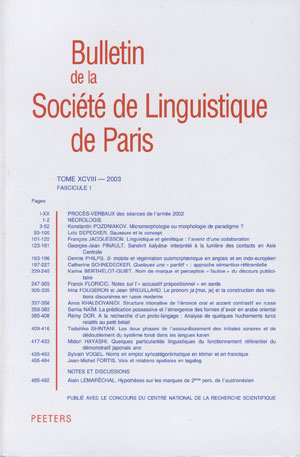 previous article in this issue previous article in this issue | next article in this issue  |

Preview first page |
Document Details : Title: L'enclitique =kin en finnois Subtitle: Entre indéfinition et focalisation Author(s): DUVALLON, Outi Journal: Bulletin de la Société de Linguistique de Paris Volume: 119 Date: 2024 Pages: 301-342 DOI: 10.2143/BSL.119.0.3294013 Abstract : Cet article étudie le lien entre indéfinition et focalisation en analysant les emplois de l’enclitique finnoise =kin dans le domaine nominal. Cet élément est habituellement présenté comme une particule focalisante qui, adjointe à un SN, donne lieu à un sens inclusif-additif («aussi») ou scalaire («même»). En plus de la construction SN=kin, l’enclitique =kin entre dans la formation de certains pronoms indéfinis, à savoir jokin «quelque chose», kukin «chacun», (milloin) mikin «(tantôt) un, (tantôt) un autre». L’objectif est, d’une part, de montrer que les deux emplois de =kin ont un fondement commun et d’autre part, d’apporter des éclairages sur les valeurs discursives de la construction SN=kin en la mettant en lien avec les propriétés référentielles des pronoms indéfinis en =kin. L’analyse se fonde sur la notion de parcours, issue de la théorie des opérations énonciatives d’A. Culioli, par laquelle on entend une opération de construction de la référence consistant à parcourir une classe d’éléments sans s’arrêter à aucun d’entre eux. L’article se termine par des hypothèses sur l’évolution des emplois de =kin. La source des pronoms indéfinis en =kin réside probablement dans des expressions de libre choix, alors que la construction SN=kin peut provenir d’une structure de coordination reliant des termes opposés. This article examines the relation between indefiniteness and focalization by analyzing the uses of the Finnish clitic =kin in the nominal domain. This item is usually presented as a focus particle that yields an inclusive/additive (‘also’) or scalar (‘even’) meaning when joined to a NP. In addition to the NP=kin construction, the clitic =kin takes part in the formation of indefinite pronouns such as jokin ‘something’, kukin ‘each one’, and (milloin) mikin ‘(sometimes) one, (sometimes) another’. The aim is, firstly, to show that these two different uses of =kin have a common basis and, secondly, to shed light on the discourse functions of the NP=kin construction by relating it to the referential properties of the indefinite pronouns with =kin. The analysis is based on the concept of scanning (Fr. parcours) defined by A. Culioli in his Theory of Enunciative Operations. Scanning means a referential operation that consists in going through items in a class without stopping at any of them. The article concludes with some hypotheses about the evolution of the uses of =kin. The indefinite pronouns with =kin probably have their source in free choice expressions, while the NP=kin construction may originate from a coordination structure linking opposite terms. |
|


